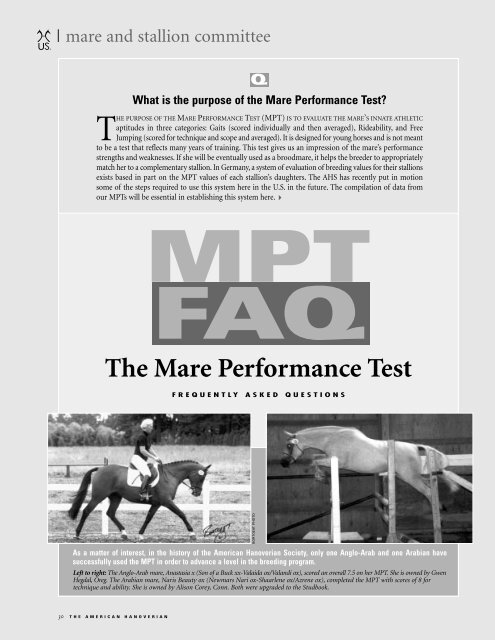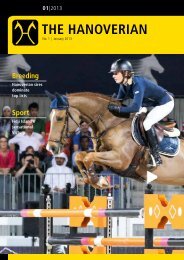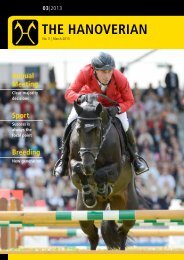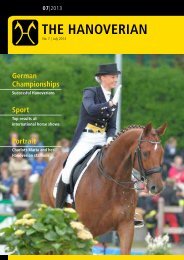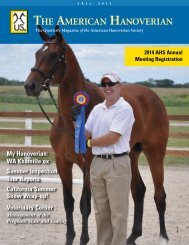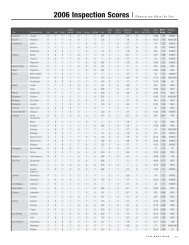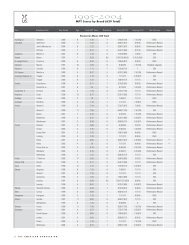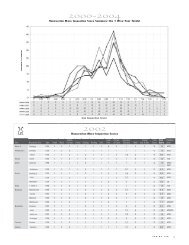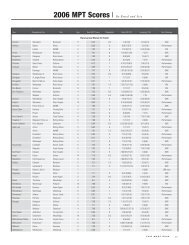MPT FACTS Article - the American Hanoverian Society!
MPT FACTS Article - the American Hanoverian Society!
MPT FACTS Article - the American Hanoverian Society!
You also want an ePaper? Increase the reach of your titles
YUMPU automatically turns print PDFs into web optimized ePapers that Google loves.
mare and stallion committee<br />
Q<br />
What is <strong>the</strong> purpose of <strong>the</strong> Mare Performance Test?<br />
THE PURPOSE OF THE MARE PERFORMANCE TEST (<strong>MPT</strong>) IS TO EVALUATE THE MARE’S INNATE ATHLETIC<br />
aptitudes in three categories: Gaits (scored individually and <strong>the</strong>n averaged), Rideability, and Free<br />
Jumping (scored for technique and scope and averaged). It is designed for young horses and is not meant<br />
to be a test that reflects many years of training. This test gives us an impression of <strong>the</strong> mare’s performance<br />
strengths and weaknesses. If she will be eventually used as a broodmare, it helps <strong>the</strong> breeder to appropriately<br />
match her to a complementary stallion. In Germany, a system of evaluation of breeding values for <strong>the</strong>ir stallions<br />
exists based in part on <strong>the</strong> <strong>MPT</strong> values of each stallion’s daughters. The AHS has recently put in motion<br />
some of <strong>the</strong> steps required to use this system here in <strong>the</strong> U.S. in <strong>the</strong> future. The compilation of data from<br />
our <strong>MPT</strong>s will be essential in establishing this system here. <br />
<strong>MPT</strong><br />
FAQ<br />
The Mare Performance Test<br />
FREQUENTLY ASKED QUESTIONS<br />
BORTOEAT PHOTO<br />
As a matter of interest, in <strong>the</strong> history of <strong>the</strong> <strong>American</strong> <strong>Hanoverian</strong> <strong>Society</strong>, only one Anglo-Arab and one Arabian have<br />
successfully used <strong>the</strong> <strong>MPT</strong> in order to advance a level in <strong>the</strong> breeding program.<br />
Left to right: The Anglo-Arab mare, Anastasia x (Son of a Buck xx-Valaida ox/Valandi ox), scored an overall 7.5 on her <strong>MPT</strong>. She is owned by Gwen<br />
Hegdal, Oreg. The Arabian mare, Naris Beauty ox (Newmars Nari ox-Shaarlene ox/Azrene ox), completed <strong>the</strong> <strong>MPT</strong> with scores of 8 for<br />
technique and ability. She is owned by Alison Corey, Conn. Both were upgraded to <strong>the</strong> Studbook.<br />
30 THE AMERICAN HANOVERIAN
Q What is gained by doing <strong>the</strong> <strong>MPT</strong>?<br />
Every mare that takes <strong>the</strong> test will have her papers stamped to indicate<br />
that she has been performance tested. A permanent record will be<br />
on file in <strong>the</strong> AHS Central Office. If she is <strong>the</strong> daughter of a Main<br />
Studbook mare and is herself in <strong>the</strong> Main Studbook with an overall<br />
score of 7.0 or better, she can become an Elite Mare Candidate<br />
upon successful completion of <strong>the</strong> <strong>MPT</strong>. This means an overall<br />
score of 7.0 or higher (i.e. at least 21 points) or an 8 in one of <strong>the</strong><br />
three sections scored, with <strong>the</strong> o<strong>the</strong>r two sections scoring 6 (i.e. 20<br />
points). To complete <strong>the</strong> process and to obtain <strong>the</strong> title of Elite<br />
Mare, she must produce an AHS registered foal within three years.<br />
The Elite Mare title given in America is similar to <strong>the</strong> States<br />
Premium designation used in Germany.<br />
A Pre-Studbook Thoroughbred, Arab or Anglo-Arab mare can move<br />
up one level to <strong>the</strong> Studbook with <strong>the</strong> successful completion of <strong>the</strong><br />
<strong>MPT</strong> with a score of 7 (or an 8 and two 6s). They cannot, however,<br />
obtain Elite Mare status as <strong>the</strong> EM title is reserved for eligible<br />
<strong>Hanoverian</strong> Main Studbook mares only. As a matter of interest, in <strong>the</strong><br />
history of <strong>the</strong> <strong>American</strong> <strong>Hanoverian</strong> <strong>Society</strong>, only 34 Thoroughbred<br />
mares, one Arabian and one Anglo-Arab have successfully used <strong>the</strong><br />
<strong>MPT</strong> in order to advance a level in <strong>the</strong> breeding program.<br />
of <strong>the</strong> evaluation goes very much like a normal training session<br />
(please see “How do I begin to train my mare to free jump?” on page 33).<br />
If <strong>the</strong> mare likes this job, is clever and willing, <strong>the</strong>n she might be<br />
tested up to 4'-4'6"h by 3'-3'6"w. This would be <strong>the</strong> exceptional mare.<br />
There is no hard and fast rule as to how high <strong>the</strong> mare must jump, but<br />
<strong>the</strong> mare should be able to jump <strong>the</strong> larger oxer set at approximately<br />
3'6"h by 3'w. The judges will give <strong>the</strong>ir scores for technique and scope.<br />
If <strong>the</strong> mare is uninspected, <strong>the</strong>n you will be asked to present <strong>the</strong><br />
mare in-hand for conformation scores. You will be asked to walk<br />
her straight away from <strong>the</strong> judges and back for <strong>the</strong> correctness score.<br />
You might be asked to trot her in-hand if she only cantered in her<br />
free jumping warm up, or if <strong>the</strong> judges feel that she has a better trot<br />
than she showed at liberty. The mare will be asked to walk in a large<br />
circle in a group with <strong>the</strong> o<strong>the</strong>r mares being inspected at <strong>the</strong> site.<br />
The under saddle portion of <strong>the</strong> <strong>MPT</strong> is usually separated from <strong>the</strong><br />
free jumping by <strong>the</strong> inspection of <strong>the</strong> non-<strong>Hanoverian</strong> mares. This is<br />
to give both you and your mare a break. The mares will be evaluated<br />
in groups of two or three mares at a time. The test is run “manege”<br />
style, meaning that <strong>the</strong>re is a leader and <strong>the</strong> rest follow behind each<br />
o<strong>the</strong>r by three to four horse lengths. You should follow <strong>the</strong> person<br />
Q Which mares are eligible to take <strong>the</strong> <strong>MPT</strong>?<br />
Any mare registered with <strong>the</strong> AHS, and any non-<strong>Hanoverian</strong> mare<br />
that is entered into one of our studbooks can take <strong>the</strong> <strong>MPT</strong>. All<br />
Prior to free jumping, mares are allowed to loosen up and warm<br />
up in <strong>the</strong> arena. During this time, <strong>the</strong> judges will take note of her<br />
trot at liberty, as this, for most mares, will be her best trot.<br />
Right: Wrave (Wallstreet Kid-EM Georgey Girl/Garibaldi II) scored 8<br />
for technique and scope/ability and was high scoring mare of <strong>the</strong><br />
2002 Hilltop Farm test. Bred by Pat Limage, Va., and owned by<br />
Kathleen and Barb Poniatowski, Md.<br />
eligible mares are encouraged to do <strong>the</strong> <strong>MPT</strong>. The AHS encourages<br />
all owners and breeders to test <strong>the</strong>ir mares to determine strengths<br />
and weaknesses in order to fur<strong>the</strong>r evaluate <strong>the</strong> future performance<br />
use of <strong>the</strong> animal, <strong>the</strong> future breeding choices for <strong>the</strong> mare, and to<br />
begin a process of keeping statistical data on <strong>the</strong>ir sires.<br />
Q How does my mare benefit from <strong>the</strong><br />
designation of Elite Mare?<br />
Your mare benefits from <strong>the</strong> honor of being identified as one of <strong>the</strong><br />
best broodmares in <strong>the</strong> country. This is not a performance award,<br />
but ra<strong>the</strong>r a breeding award, and that is why <strong>the</strong> mares must prove<br />
that <strong>the</strong>y are reproductively sound by having an AHS registered foal<br />
within three years of becoming an Elite Mare Candidate. There is<br />
also <strong>the</strong> benefit of obtaining reduced stud fees from some stallion<br />
owners for Elite Mares.<br />
Q How will <strong>the</strong> test be run? What should I expect?<br />
The mares will be free jumped first. If your mare has not previously<br />
been inspected, she will be inspected during her free jumping time.<br />
She will be allowed to loosen up and warm up in <strong>the</strong> arena. During<br />
this time, <strong>the</strong> judges will take note of her trot at liberty, as this, for<br />
most mares, will be her best trot.<br />
You will be asked how much free jumping <strong>the</strong> mare has done and if<br />
she needs to have all <strong>the</strong> rails down to <strong>the</strong> ground to start. The rest<br />
in front of you, even if <strong>the</strong>y make a mistake. It is very important<br />
that this distance between <strong>the</strong> horses be kept <strong>the</strong> same during <strong>the</strong><br />
entire test, even if you have to cut across <strong>the</strong> arena or go deep into<br />
<strong>the</strong> corners. Certain exercises will have to be repeated if <strong>the</strong> mares<br />
spread too far apart.<br />
A sample test could be as follows: You’ll be asked to pick up a rising<br />
trot, complete a 20 meter circle at one end followed by a leng<strong>the</strong>ning<br />
down <strong>the</strong> long side, <strong>the</strong>n change across <strong>the</strong> diagonal and do <strong>the</strong><br />
same on <strong>the</strong> o<strong>the</strong>r rein. In a 20 meter circle you’ll be asked to prepare<br />
for canter and <strong>the</strong>n canter in <strong>the</strong> circle, <strong>the</strong>n go straight on with<br />
leng<strong>the</strong>ning down one long side, change leads through <strong>the</strong> trot<br />
across on <strong>the</strong> diagonal, and do <strong>the</strong> same on <strong>the</strong> o<strong>the</strong>r rein. When<br />
<strong>the</strong> judges have scores for trot and canter for each mare, you will be<br />
asked for a free walk on a long rein down <strong>the</strong> long sides, and perhaps<br />
across <strong>the</strong> arena. After this part, <strong>the</strong> judges should have scores for<br />
all three gaits. The short rideability part comes next. You’ll be asked<br />
to pick up a rising trot and ride a three loop serpentine <strong>the</strong> width<br />
of <strong>the</strong> arena, probably twice, <strong>the</strong>n develop canter at one end and<br />
canter across <strong>the</strong> diagonal with a change of lead through <strong>the</strong> trot at<br />
X and do <strong>the</strong> same on <strong>the</strong> o<strong>the</strong>r rein. You will <strong>the</strong>n walk and at <strong>the</strong><br />
end demonstrate a halt with immobility. This ‘test’ can change<br />
dramatically from site to site depending upon how well <strong>the</strong> group<br />
can stay toge<strong>the</strong>r, and if all <strong>the</strong> mares are behaving well. <br />
SPRING 2003 31
Mare Performance Test FAQ<br />
Q What should I wear? What saddlery is allowed?<br />
The proper attire for presenting <strong>the</strong> mare for free jumping and<br />
inspection is a conservative polo shirt and khaki pants with running<br />
shoes. For <strong>the</strong> under saddle portion, <strong>the</strong> rider should wear a white<br />
polo shirt or ratcatcher with conservative colored jacket (optional<br />
at 85 degrees and higher), light colored breeches and riding boots.<br />
Chaps and half chaps are discouraged. Saddlery must include a<br />
snaffle bridle for free jumping (minus <strong>the</strong> reins), for presentation<br />
and for <strong>the</strong> under saddle portion. The saddle must be of English<br />
style (no western, racing or steeplechase saddles). Protective boots<br />
and bandages are allowed for <strong>the</strong> free jumping portion only.<br />
In free jumping <strong>the</strong> mare will receive two scores, one for<br />
<strong>the</strong> technique and one for <strong>the</strong> scope or ability.<br />
Right: EM Pirouette (Pik Solo-Glueckskind/Gigant) scored an overall 7.5<br />
on her <strong>MPT</strong>, including an 8 for ability and 7 for technique for her jumping.<br />
Bred by Mary Jill Fisher, Calif., and owned by Caroline Hegarty, Calif.<br />
Q What do <strong>the</strong> scores mean?<br />
The <strong>MPT</strong> is scored in whole numbers only and <strong>the</strong> rounding up<br />
of scores is not permitted. A score of 4 is ‘insufficient’ and is<br />
rarely given; a 5 is ‘sufficient’ but is a low ‘passing’ score; a 6 is<br />
‘satisfactory’ and is an average score; a 7 is ‘fairly good’ and is an<br />
above average score; an 8 is ‘good’ and is a substantially above<br />
average score; a 9 is ‘very good’ and is nearly exceptional; a 10 is<br />
‘superior’ and is quite exceptional.<br />
In free jumping <strong>the</strong> mare will receive two scores, one for <strong>the</strong><br />
technique and one for scope or ability. The first score evaluates<br />
<strong>the</strong> mare’s ability to use (or control <strong>the</strong> individual parts of) her<br />
entire body to negotiate a jump. She must have some arch to her<br />
back, a bascule, be able to pick up her front and back legs so that<br />
<strong>the</strong> forearm is parallel to <strong>the</strong> ground and so that <strong>the</strong> hind legs do<br />
not trail behind and pull rails. Tucking <strong>the</strong> knees up into <strong>the</strong> chin and<br />
kicking up behind can only earn <strong>the</strong> mare more technique score.<br />
The next score is for scope. Scope assesses <strong>the</strong> ability to jump a big<br />
fence or to get to <strong>the</strong> bottom of a fence and show <strong>the</strong> power to<br />
jump up and over. The higher <strong>the</strong> score here, <strong>the</strong> more likely <strong>the</strong><br />
mare could be a jumper. These two scores are averaged to give one<br />
jumping score. Demonstration of <strong>the</strong> ability to jump a higher and<br />
wider fence is required for a score of 8 or higher in this category.<br />
In <strong>the</strong> under saddle portion of <strong>the</strong> test, <strong>the</strong> mare will receive a score<br />
for walk, trot and canter, and <strong>the</strong>se three scores will be added<br />
toge<strong>the</strong>r and divided by three for <strong>the</strong> gait score. She will also receive<br />
a separate score for rideability. This rideability score is a reflection<br />
of <strong>the</strong> mare’s willingness to accept <strong>the</strong> rider’s aids, her suppleness,<br />
her generosity, her ability to make <strong>the</strong> movements seem easy, and<br />
her natural balance, lightness and freedom. Just because <strong>the</strong> mare<br />
appears to be ‘on <strong>the</strong> bit’, or is more probably only flexed at <strong>the</strong><br />
poll, doesn’t mean that she is soft in <strong>the</strong> jaw and swinging through<br />
<strong>the</strong> back. A mare that scores high here is a mare that everyone<br />
would love to have <strong>the</strong> chance to ride, and conversely, <strong>the</strong> mare<br />
that scores low here, is <strong>the</strong> one people would prefer not to ride<br />
Q How do you construct a free jumping chute?<br />
Free jumping is best done in an indoor arena with mirrors<br />
covered. The chute should be set against a long wall. This long<br />
side wall of <strong>the</strong> arena must be imposing enough in height that<br />
<strong>the</strong> mare would never be tempted to jump over it. The side of <strong>the</strong><br />
chute near <strong>the</strong> center of <strong>the</strong> arena needs to be imposing enough<br />
(maybe 4') to discourage <strong>the</strong> mare from ‘escaping’. For <strong>the</strong> side of<br />
<strong>the</strong> chute, you can use one or two rails in between <strong>the</strong> standards<br />
and leave a small blank space on <strong>the</strong> landing side of each oxer so<br />
a person can slip in to adjust <strong>the</strong> height or to do fence repair.<br />
There are two types of jumping chutes: closed and open. The closed<br />
chute has an ‘end’ or ‘wall’ at one end so <strong>the</strong> mares must stop after<br />
<strong>the</strong> last jump. The open chute allows <strong>the</strong> mares to run out of <strong>the</strong><br />
chute. This gives <strong>the</strong> trainer <strong>the</strong> option of allowing her to return<br />
to <strong>the</strong> beginning of <strong>the</strong> chute by herself, or to be caught and led<br />
in. Letting her return to <strong>the</strong> beginning of <strong>the</strong> chute by herself allows<br />
her to keep going at a good canter stride after <strong>the</strong> larger oxer. It<br />
is very important that if you opt for a closed chute, <strong>the</strong> ‘end’ of<br />
<strong>the</strong> chute not be closer than 45 feet after <strong>the</strong> larger oxer, o<strong>the</strong>rwise<br />
<strong>the</strong> mares will possibly back off <strong>the</strong> last jump, break to a trot right<br />
after it or refuse to jump into what appears to <strong>the</strong>m to be a trap.<br />
It is best to err on <strong>the</strong> generous side and make <strong>the</strong> ‘end’ far<strong>the</strong>r<br />
than closer to <strong>the</strong> last jump. The closed chute must also have a<br />
‘gate’. This is to allow <strong>the</strong> mare a place to exit. It is usually just a<br />
single pole between two standards near <strong>the</strong> ‘end’. A bucket of<br />
grain available here can help catch <strong>the</strong> mares and avoid having<br />
<strong>the</strong>m use up too much energy in an effort to avoid being caught.<br />
The start of <strong>the</strong> open chute needs to be built a bit closer to <strong>the</strong><br />
short end, so <strong>the</strong> mare running free can use <strong>the</strong> short turn to collect<br />
herself before <strong>the</strong> first ‘X’. This open chute will not need as many<br />
materials as <strong>the</strong> closed chute, but of course both will need a side<br />
barrier to keep <strong>the</strong> mares inside <strong>the</strong> chute. For both, you will need<br />
lots of jump cups. Be sure to store any extra jump cups on top of <strong>the</strong><br />
arena kick wall or in a bucket, but not at <strong>the</strong> base of <strong>the</strong> standards.<br />
This is for obvious safety reasons. You will need materials for <strong>the</strong><br />
side chute, and three jumps, — one ‘X’, a small oxer and a larger<br />
oxer. You will need enough poles to construct <strong>the</strong> jumps and a<br />
few extra for breakage. Please use normal poles - no telephone poles.<br />
If your arena wall is slanted, you will need to add a triangular<br />
piece of cardboard or wood to <strong>the</strong> jump standards that are<br />
against <strong>the</strong> wall so <strong>the</strong> mare will not try to squeeze between <strong>the</strong><br />
standard and <strong>the</strong> wall. Special standards can also be constructed<br />
SHERI SCOTT PHOTO<br />
32 THE AMERICAN HANOVERIAN
to hang vertically from <strong>the</strong> kick wall. The first jump is just a simple ‘X’,<br />
followed by 22'6" (6.8m) to a small oxer, followed by 23'1" (7.0m) to<br />
a larger oxer. Be sure to use a ground rail at every jump. These distances<br />
are tried and true and <strong>the</strong>y work well for mares prepared<br />
well. Very inexperienced mares that hesitate and go too slowly or<br />
conversely, those that flatten out and go too quickly through <strong>the</strong><br />
chute, may find <strong>the</strong>se distances too long or too short.<br />
Q How do I begin to train my mare to free jump?<br />
Brushing boots and bell boots are allowed and you should use <strong>the</strong>m.<br />
It is best not to use polo wraps as <strong>the</strong>y can unwind during a round and<br />
become very dangerous.You will need a small bucket of feed as a reward<br />
after each round, a person to lead <strong>the</strong> mare in, who could also be <strong>the</strong><br />
same person that catches <strong>the</strong> mare. You will need at least two whip<br />
handlers using longe whips that have had lots of experience in jumping<br />
and have a good eye for jump take-off timing. It would also be nice<br />
if you had a lea<strong>the</strong>r lead strap made approximately two feet long to<br />
lead <strong>the</strong> mare into <strong>the</strong> chute and to catch her after each round.<br />
The first few times <strong>the</strong> mare goes through <strong>the</strong> chute, a whip handler<br />
should follow behind <strong>the</strong> mare to prevent her from turning around<br />
and running out <strong>the</strong> in-gate. One whip handler is stationed between<br />
jump one and two and <strong>the</strong> o<strong>the</strong>r between jump two and three. It is best<br />
not to hit <strong>the</strong> mare but to drop <strong>the</strong> lash down behind her so as to<br />
encourage her on through <strong>the</strong> chute. But forward progress is essential,<br />
and if she stops, she must realize that <strong>the</strong> only place to go is forward.<br />
You can start by leading <strong>the</strong> mare over three ‘piles’ of rails where <strong>the</strong><br />
jumps will be. Do this until she walks quietly over all <strong>the</strong> piles. Then<br />
walk her over <strong>the</strong> first pile, pick up a jog and <strong>the</strong>n <strong>the</strong> two of you<br />
jog over <strong>the</strong> next two piles. Do this until she is confident – for some,<br />
it’s one time and for o<strong>the</strong>rs, it’s many times. Next have your helpers with<br />
longe whips in place. Let her jog through on her own. Now you’re<br />
ready for some construction. The following is one suggestion: 1) two<br />
piles to an ‘X’; 2) one pile to two ‘X’s; 3) three ‘X’s; 4) two ‘X’s to a<br />
small vertical; 5) one ‘X’ to two small verticals. The mare will tell<br />
you when it’s enough for <strong>the</strong> first session. It is far better to go slow, and<br />
let her be confident and want to do <strong>the</strong> exercise again, than do too<br />
much,get her tired or overface her and have her lose confidence.<br />
In future training sessions, you advance from <strong>the</strong> ‘X’ and two small<br />
verticals to an ‘X’ to a small oxer (not square) to a larger oxer (also<br />
not square). Be sure to widen <strong>the</strong> oxer as you raise it and pull out<br />
CARLA CARLETON PHOTO<br />
<strong>the</strong> ground line some. The middle jump (<strong>the</strong> smaller oxer) usually<br />
stays at about 2'6" or 2'9"h by 2' or 2'3" w — this is a rounding<br />
fence, and for most mares, it helps set <strong>the</strong>m up for a good go at <strong>the</strong><br />
bigger oxer. The final oxer is <strong>the</strong> one that gets raised in height and<br />
width to <strong>the</strong> mare’s highest capability. If your mare gets quick and<br />
rushes <strong>the</strong> fences, she might need to be led into <strong>the</strong> chute at a walk.<br />
You can also put in ground poles halfway in between <strong>the</strong> jumps to<br />
make sure she puts in a canter stride and doesn’t try to bounce.<br />
These ground lines halfway in between <strong>the</strong> jumps, make <strong>the</strong> mare<br />
look, be careful, pay attention and slow up.<br />
I believe that a closed chute works better for most mares, because of<br />
<strong>the</strong> mares’ lack of training and conditioning. They do not have enough<br />
‘bottom’ to gallop around for five or ten minutes and play ‘catch me<br />
if you can’ in between each round. The closed chute saves time for<br />
all and saves <strong>the</strong> mare from running out of gas before she can progress<br />
enough each session. In <strong>the</strong> <strong>MPT</strong>, it could help her show what she<br />
can do before tiring out. This does not mean that an open chute is not<br />
acceptable or even better for some mares and some circumstances.<br />
The open chute can teach <strong>the</strong> mare to adjust her stride better.<br />
Every practice session at home need not test <strong>the</strong> mare to her highest<br />
capability. Ra<strong>the</strong>r, a slow steady build up of <strong>the</strong> height and spread of<br />
<strong>the</strong> jumps can instill confidence in <strong>the</strong> novice mare. If a bad schooling<br />
session happens, it is always best to go back down in difficulty until<br />
confidence is restored. Try to come to <strong>the</strong> test knowing <strong>the</strong> capabilities<br />
of your mare.<br />
Experience shows that <strong>the</strong> best-prepared mares usually are<br />
rewarded with <strong>the</strong> best scores for <strong>the</strong> day.<br />
Left: EM Wunder (Wer<strong>the</strong>rson-Deidre’s Decision/Dollberg) received a<br />
jumping ability score of 8. Bred by Cindy Wilkes, Ga., and owned by<br />
Jill Peterson, Fla.<br />
Q How often do I need to free jump?<br />
Free jumping can be great fun for everyone, especially <strong>the</strong> mare. It<br />
is disheartening to see ill-prepared mares make mistakes at <strong>the</strong> testing<br />
that should have been addressed at home. Free jumping should be<br />
done once a week for six to eight weeks before <strong>the</strong> testing. If <strong>the</strong><br />
mare is clever and has some jumping talent, <strong>the</strong>n she may catch on<br />
quickly and <strong>the</strong> extra sessions just build up more confidence. But<br />
for <strong>the</strong> mare that isn’t so clever or talented, she needs every single<br />
session she can get to do her personal best with confidence <strong>the</strong> day<br />
of <strong>the</strong> <strong>MPT</strong>. Experience shows that <strong>the</strong> best-prepared mares usually<br />
are rewarded with <strong>the</strong> best scores for <strong>the</strong> day.<br />
Hopefully this gives you some idea of what to expect at a <strong>MPT</strong>. The<br />
Mare and Stallion Committee members always remain available to<br />
help clarify and answer any questions you may have. If <strong>the</strong>re are<br />
inspections sites in your area, it is a good idea to go watch one<br />
before bringing your mare. Many of <strong>the</strong> inspection site hosts offer<br />
schooling sessions prior to <strong>the</strong> <strong>MPT</strong> day. Take advantage of clinics<br />
that may be offered. The judges and inspection site hosts want this<br />
to be a positive experience for both you and your mare. Have a<br />
happy and safe testing. Give it a try and good luck! ■<br />
AHS board member Suzanne Quarles was appointed to <strong>the</strong> AHS<br />
Mare and Stallion Committee in 1997. She judges extensively and<br />
has been a US Equestrian-licensed Combined Training judge and<br />
Technical Delegate since 1976.<br />
SPRING 2003 33


